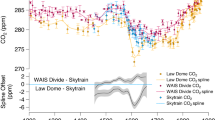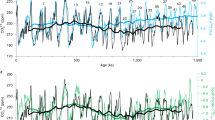Abstract
When snow is transformed into ice (firnification process) by sedimentation near the surface of an ice sheet, some of the atmospheric air is trapped in the inter-grain spaces which are progressively isolated from the surrounding atmosphere. The resulting material is an air-tight bubbly glacial ice. By analysing the air extracted from the bubbles found in the ice, it is possible to determine the air composition and thus its CO2 content for the period during which the air was trapped. We aim here to provide the most direct evidence obtained so far for the background atmospheric CO2 concentrations over the centuries preceding the recent anthropogenic perturbation due to the industrial revolution of the past century. This background level is important for assessing both the origin and the climatic response of the anthropogenic perturbation to the atmospheric CO2 (see ref. 1). Our results, obtained from the analysis of the air trapped in the bubbles of an Antarctic ice core, indicate that the background level could have been as low as 260 p.p.m.v. (parts per million by volume) before the major anthropogenic influence and suggest that the so-called ‘pre-industrial’ CO2 level was not constant over the few hundred years preceding the nineteenth century.
This is a preview of subscription content, access via your institution
Access options
Subscribe to this journal
Receive 51 print issues and online access
$199.00 per year
only $3.90 per issue
Buy this article
- Purchase on Springer Link
- Instant access to full article PDF
Prices may be subject to local taxes which are calculated during checkout
Similar content being viewed by others
References
Schneider, S. H. Climatic Change 5, 311–313 (1983).
Lorius, C. & Raynaud, D. in Carbon Dioxide: Current Views and Developments in Energy/ Climate Research (eds Bach, W. et al.) 145–176 (Reidel, Dordrecht, 1983).
Barnola, J. M., Raynaud, D., Neftel, A. & Oeschger, H. Nature 303, 410–412 (1983).
Stauffer, B. & Oeschger, H. Ann. Glaciol. (in the press).
Anderson, D. L. & Benson, C. S. in Ice and Snow; Properties, Processes and Applications (ed. Kingery, W. D.) 391–411 (MIT Press, 1963).
Schwander, J. & Stauffer, B. Nature 311, 45–47 (1984).
Zanolini, F., Delmas, R. J. & Legrand, M. Ann. Glaciol. (in the press).
World Meteorological Office. Project on Research and Monitoring of Atmospheric CO2 Rep. No. 10 (WMO, Geneva, 1983).
Elliott, W. P. et al. EOS 65, 416–417 (1984).
Keeling, C. D., Bacastow, R. B. & Whorf, T. P. in Carbon Dioxide Review: 1982 (ed. Clark, W. C.) 377–385 (Oxford University Press, 1982).
Author information
Authors and Affiliations
Rights and permissions
About this article
Cite this article
Raynaud, D., Barnola, J. An Antarctic ice core reveals atmospheric CO2 variations over the past few centuries. Nature 315, 309–311 (1985). https://doi.org/10.1038/315309a0
Received:
Accepted:
Issue Date:
DOI: https://doi.org/10.1038/315309a0
This article is cited by
-
Ancient atmosphere- Validity of ice records
Environmental Science and Pollution Research (1994)
-
Atmospheric carbon dioxide and the ocean
Nature (1993)
Comments
By submitting a comment you agree to abide by our Terms and Community Guidelines. If you find something abusive or that does not comply with our terms or guidelines please flag it as inappropriate.



